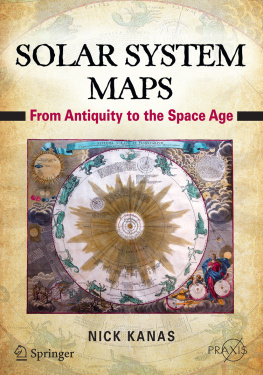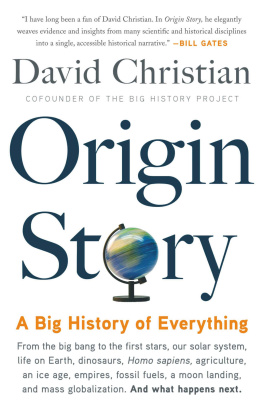The publisher gratefully acknowledges
the generous contribution to this book
provided by the Ahmanson Foundation
Humanities Fund and the General
Endowment Fund of the University
of California Press Associates.
MAPS OF TIME
THE CALIFORNIA WORLD HISTORY LIBRARY
Edited by Edmund Burke III, Kenneth Pomeranz, and Patricia Seed
1. The Unending Frontier: Environmental History of the Early Modern World, by John F. Richards
2. Maps of Time: An Introduction to Big History, by David Christian
3. The Graves of Tarim: Genealogy and Mobility across the Indian Ocean, by Engseng Ho
4. Imperial Connections: India in the Indian Ocean Arena, 18601920, by Thomas R. Metcalf
5. Many Middle Passages: Forced Migration and the Making of the Modern World, edited by Emma Christopher, Cassandra Pybus, and Marcus Rediker
6. Domesticating the World: African Consumerism and the Genealogies of Globalization, by Jeremy Prestholdt
7. Servants of the Dynasty: Palace Women in World History, edited by Anne Walthall
8. Island World: A History of Hawaii and the United States, by Gary Y. Okihiro
9. The Environment and World History, edited by Edmund Burke III and Kenneth Pomeranz
10. Pineapple Culture: A History of the Tropical and Temperate Zones, by Gary Y. Okihiro
11. The Pilgrim Art: Cultures of Porcelain in World History, by Robert Finlay
12. The Quest for the Lost Nation: Writing History in Germany and Japan in the American Century, by Sebastian Conrad; translated by Alan Nothnagle
13. The Eastern Mediterranean and the Making of Global Radicalism, 18601914, by Ilham Khuri-Makdisi
14. The Other West: Latin America from Invasion to Globalization, by Marcello Carmagnani
15. Mediterraneans: North Africa and Europe in an Age of Migration, c. 18001900, by Julia A. Clancy-Smith
16. History and the Testimony of Language, by Christopher Ehret
17. From the Indian Ocean to the Mediterranean: The Global Trade Networks of Armenian Merchants from New Julfs, by Sebouh David Aslanian
18. Berenike and the Ancient Maritime Spice Route, sby Steven E. Sidebotham
19. The Haj to Utopia: The Ghadar Movement and Its Transnational Connections, 19051930, by Maia Ramnath
Epigraph: the final verse of the Diamond Sutra, as translated by Kenneth Saunders, in The Wisdom of Buddhism, ed. Christmas Humphreys (London: Curzon Press, 1987), p. 122.
University of California Press, one of the most distinguished university presses in the United States, enriches lives around the world by advancing scholarship in the humanities, social sciences, and natural sciences. Its activities are supported by the UC Press Foundation and by philanthropic contributions from individuals and institutions. For more information, visit www.ucpress.edu.
University of California Press
Berkeley and Los Angeles, California
University of California Press, Ltd.
London, England
First paperback printing 2005
2004, 2011 by The Regents of the University of California
ISBN 978-0-520-27144-9 (pbk. : alk. paper)
The Library of Congress has cataloged an earlier edition as follows:
Library of Congress Cataloging-in-Publication Data
Christian, David, 1946.
Maps of time : an introduction to big history / David Christian.
p. cm.(The California world history library; 2)
Includes bibliographical references and index.
ISBN 978-0-520-24476-4 (pbk. : alk. paper)
1. CivilizationPhilosophy. 2. Human evolution. 3. World history. I. Title. II. Series.
CB 19.C477 2003
901dc21
2003012764
Manufactured in the United States of America
20 19 18 17 16 15 14 13 12 11
10 9 8 7 6 5 4 3 2 1
The paper used in this publication meets the minimum requirements of ANSI/NISO Z39.48-1992 ( R 1997) (Permanence of Paper).
Thus shall ye think of all this fleeting world:
A star at dawn, a bubble in a stream,
A flash of lightning in a summer cloud,
A flickering lamp, a phantom, and a dream.
Diamond Sutra, ca. fourth century CE
CONTENTS
ILLUSTRATIONS
TIMELINES
MAPS
FIGURES
TABLES
FOREWORD
Maps of Time unites natural history and human history in a single, grand, and intelligible narrative. This is a great achievement, analogous to the way in which Isaac Newton in the seventeenth century united the heavens and the earth under uniform laws of motion; it is even more closely comparable to Darwins nineteenth-century achievement of uniting the human species and other forms of life within a single evolutionary process.
The natural history that David Christian deals with in the first chapters of this book is itself radically extended and transformed from the natural history of earlier ages. It starts with the big bang some 13 billion years ago, when, according to twentieth-century cosmologists, the universe we inhabit began to expand and transform itself. Processes thereby inaugurated are still in course, as time and space (perhaps) began, allowing matter and energy to separate from one another and distribute themselves throughout space in different densities and with different rates of energy flows in response to a variety of strong and weak forces. Matter, gathering into local clots under the influence of gravity, became radiant stars, clustered into galaxies. New complexities, new flows of energy arose around such structures. Then, some 4.6 billion years ago, around one star, our sun, planet Earth formed and soon became the seat of still more complicated processes, including life in all its forms. Humankind added yet another level of behavior a mere 250,000 years ago, when our use of language and other symbols began to introduce a new capacity for what Christian calls collective learning. This in turn made human societies uniquely capable of concerting common effort so as to alter and sporadically expand widely varying niches in the ecosystem around each of them and, by now, surround us all in the single, global system.
The human history that Christian thus fits into the recently elaborated natural history of the universe is also an intellectual creation of the twentieth century. For while the efforts of physicists, cosmologists, geologists, and biologists were making the natural sciences historical, anthropologists, archaeologists, historians, and sociologists were busy enlarging knowledge about the human career on earth. They extended it back in time and expanded it pretty well across the face of the earth to embrace foragers, early farmers, and other peoples who left no written records and had therefore been excluded from document-based scientific history in the nineteenth century.
Most historians, of course, paid no attention to prehistory, or to the lives of illiterate peoples, busy as they were with their own professional debates. Across the twentieth century, those debates, and the study of abundant Eurasian and a few African and Amerindian texts, added substantially to the sum of historical information and to the scope of our ideas about the accomplishments of the urbanized, literate, and civilized peoples of the earth. A few world historians, like myself, tried to weave those researches together into a more adequate portrait of humanitys career as a whole; and some also explored the ecological impact of human activity I even wrote a programmatic essay, History and the Scientific Worldview (
Next page










